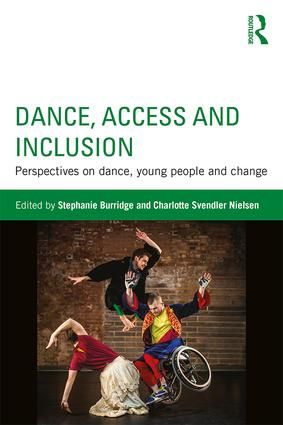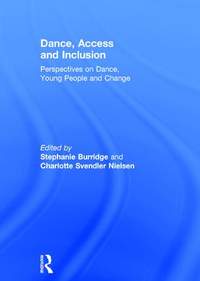
Dance, Access and Inclusion: Perspectives on Dance, Young People and Change
- Editor: Burridge, Stephanie
- Editor: Nielsen, Charlotte Svendler
Book
$56.00Out of Stock
Contents
- 0. Prelims
- i. List of contributors
- ii. Acknowledgement
- iii. Introduction
- 1.Inclusive dance pedagogy
- Chapters
- 1.1 Making no difference: inclusive dance pedagogy (Sarah Whatley and Kate Marsh)
- 1.2 Developing inclusive dance pedagogy: dialogue, activism and aesthetic transformative learning (Tone Pernille Ostern)
- Case narratives
- 1.3 Beyond technique: diversity in dance as a transformative practice (Phillip Channells)
- 1.4 Exploring the relationship between dance and disability: a personal journey (Jackie Prada)
- 1.5 "Sowing dance" body movement for children from six months to three years old: the experience in Mesquita, Brazil (Luciana Veiga)
- 1.6 Dance for children with dyspraxia: the impact of Royal Academy of Dance, London, projects (Lesley Ovenden)
- 2.Equality, advocacy and policy
- Chapters
- 2.1 Values and principles shaping community dance (Ralph Buck and Barbara Snook)
- 2.2 The Ugly Duckling: stories of dance and disability from Denmark and South Africa (Gerard M. Samuel)
- 2.3 Dance, education and participation: the "Planters" project in Girona, Spain (Gemma Carbo Ribugent)
- Case narratives
- 2.4 Building identity through dance: exploring the influence of dance for individuals with special needs (Nicole J. Reinders)
- 2.5 Encountering and embodying difference through dance: reflections on a research project in a primary school in Finland (Liisa Jaakonaho)
- 2.6 New spaces for creativity and action: recent developments in the Applied Performing Arts in Barcelona (Jordi Balta, Eva Garcia and Raimon Avila)
- 3. Changing practice for dance education
- Chapters
- 3.1 Making change: the identification and development of talented young dancers with disabilities (Imogen Aujla, Emma Redding and Veronica Jobbins)
- 3.2 Reflections from a/r/tography: perspectives to review creative activities with special needs children (Chung-Shiuan Chang and Shu-Hwa Jung)
- 3.3 Learning in action: intersecting approaches to teaching dance in Timor-Leste and Australia (Kym Stevens and Avril Huddy)
- Case narratives
- 3.4 Exploring disability and dance: a Papua New Guinean experience (Naomi Faik-Simet)
- 3.5 ASEAN Para Games 2015: dancing for inclusivity (Filomar Cortezano Tariao)
- 3.6 Dancing partners/ dancing peers: a wheelchair dance collaborative (Miriam Giguere and Rachel Federman-Morales)
- 4. Community dance initiatives
- Chapters
- 4.1 Dance and affect: re-connecting minds to bodies of young adult survivors of violence in India (Urmimala Sarkar Munsi)
- 4.2 Digital stories: three young people's experience in a community dance class (Sue Cheesman and Elaine Bliss)
- 4.3 Community initiatives for special needs dancers: an evolving ecology in Singapore (Stephanie Burridge)
- Case narratives
- 4.4 Celebrating diversity: a Jamaican story (Carolyn Russell Smith)
- 4.5 "I Can... ": a Cambodian inclusive arts project (Laura Evans)
- 4.6 Learning together through dance: making cultural connections in Indonesia (Gianti Giadi)
- 4.7 From the ground up: a Portuguese dance education collaboration with regional communities (Madalena Victorino in conversation with Annie Greig)
- 5. Professional integrated collaborations
- Chapters
- 5.1 Pulling back from being together: an ethnographic consideration of dance, digital technology and hikikomori in Japan and the UK (Adam Benjamin)
- 5.2 Freefalling with ballet (David Mead)
- 5.3 Troubling access and inclusion: a phenomenological study of children's learning opportunities in artistic-educational encounters with a professional contemporary dance production (Charlotte Svendler Nielsen)
- Case narratives
- 5.4 Dancing in wheelchairs: a Malaysian story (Leng Poh Gee and Anthony Meh Kim Chuan)
- 5.5 "Twilight": connection to place through an intergenerational multi-site dance project (Cheryl Stock)
- 5.6 Navi's story: access to collective identity through intercultural dance in the Fiji Islands (Sachiko Soro)
- 5.7 The value of extended residencies conducted by Restless Dance Theatre in schools 2014-2015 (Nick Hughes, Michelle Ryan and India Lennerth)



